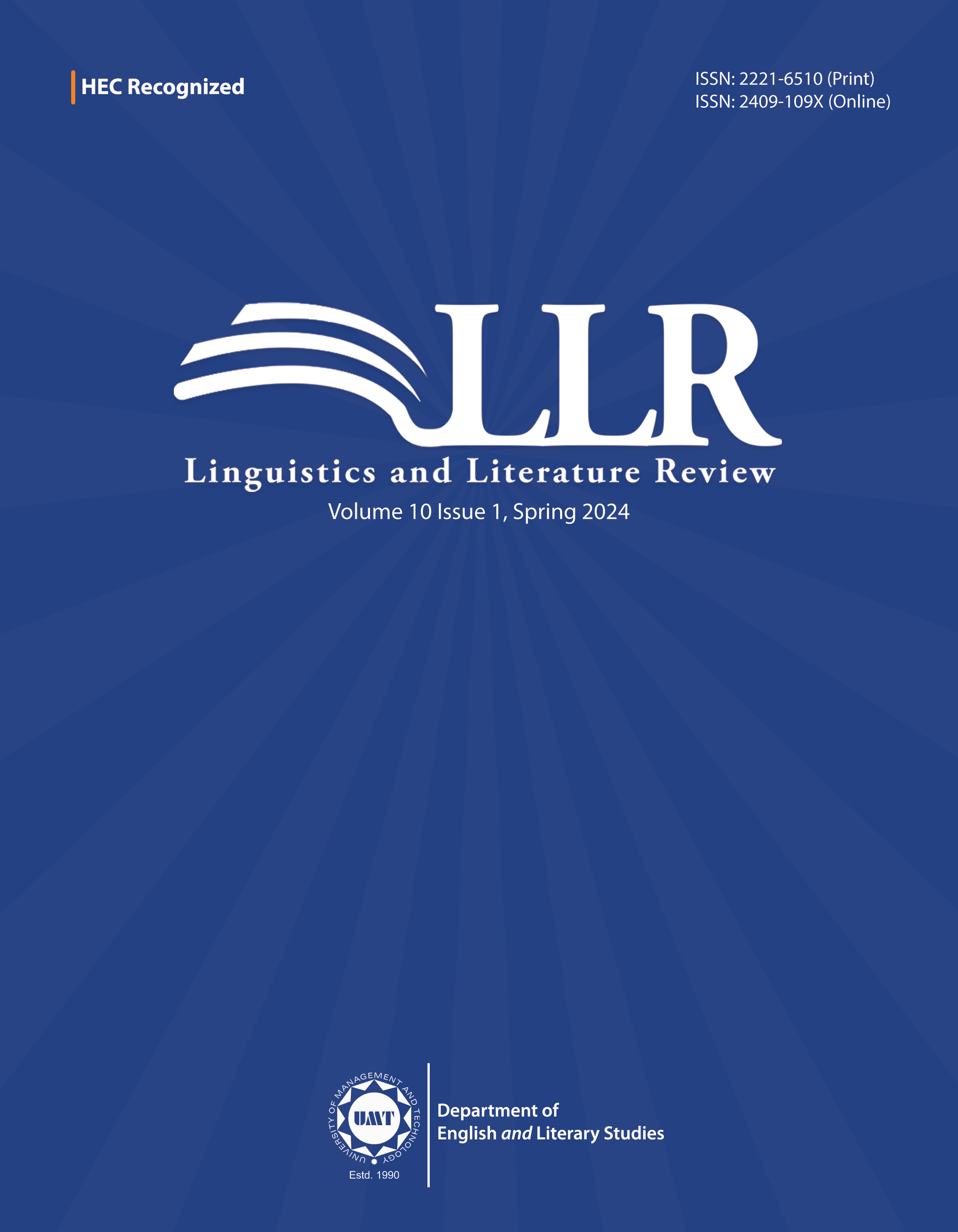Lexical Load in Class X English Textbooks: A Corpus-Based Comparative Analysis
Abstract
 Abstract Views: 0
Abstract Views: 0
English, in Pakistan, is taught since grade 1, yet the acquisition of receptive and productive skills in English language by Pakistani language learners remains questionable. The lack of vocabulary is a major factor as vocabulary is crucial for communication. In Pakistan, textbooks are the only source of vocabulary exposure for students. Keeping in view the importance of textbooks, this corpus-based research was conducted to know and compare the lexical load of Class X textbooks that are developed, published and distributed in public schools by the four textbook boards. These textbooks were evaluated on the basis of three parameters, namely the frequency of types and tokens present in textbooks and type-token ratio, the percentage of GSL/AWL covered, and the levels of BNC-COCA 25 present. The coverage of GSL/AWL lists for GSL_2nd_1000 and AWL750 was alarming. Most of the vocabulary present in these textbooks habituated first three levels of BNC-COCA 25 but rest of the levels had no or minor presentation. The results showed that these textbooks do not fulfill the needs of students as the amount of vocabulary included does not meet the internationally defined standards for vocabulary. Hence, vocabulary should be extended and distributed as per the standards.
Downloads
References
Ahmadi, A., & Derakhshan, A. (2016). EFL teachers’ perceptions towards textbook evaluation. Theory and Practice in Language Studies, 6(2), 260–267. https://doi.org/10.17507/tpls.0602.06
Alqahtani, M. (2015). The importance of vocabulary in language learning and how to be taught. International Journal of Teaching and Education, 3(3), 21–34. https://doi.org/10.20472/TE.2015.3.3.002
Azim, M. U., Hussain, Z., Bhatti, A. M., & Iqbal, M. (2020). Recycling of vocabulary in English language teaching: From theory to practice. Epistemology, 7(1), 88–102.
Azim, M. U., Hussain, Z., Bhatti, A. M., Iqbal, M., & Chohan, M. (2017). Caught between the Extremes: A comparative study of state owned news channel and a private news channel. Hamdard Islamicus, 40(2), 301–314.
Azim, U. A., & Garcia, M. I. M. (2020). Lexical load of Punjab curriculum and textbook board’s English1and English 2. Bulletin of Education and Research, 42(2), 15–32.
Cameron, L. (2001). Teaching languages to young learners. Cambridge University Press.
Chegeni, N. (2016). General English textbook evaluation: A closer look at “four corners.” Theory and Practice in Language Studies, 6(12), 2325–2330. https://doi.org/10.17507/tpls.0612.13
Government of Pakistan. (2017). National education policy 2017. https://pbit.punjab.gov.pk/system/files/National%20Educaton%20Policy%202017.pdf
Gries, S. T. (2009), What is corpus linguistics? Language and Linguistics Compass, 3, 1225–1241. https://doi.org/10.1111/j.1749-818X.2009.00149.x
Gurmani, M. T. A. A., Yosuff, Z. S., & Shahid, C. (2021). An evaluation of vocabulary of English textbooks of Pakistan and Saudi Arabia through CEFR. Palarch’s Journal of Archaeology of Egypt/Egyptology, 18(10), 3375–3387.
Hsueh-Chao, M. H., & Nation, P. (2000). Unknown vocabulary density and reading comprehension. Reading in a Foreign Language, 13(1), 403–430.
Huckin, T., Haynes, M., & Coady, J. (Eds.) (1993). Second language reading and vocabulary learning. Ablex Publishing Corporation.
Jahan, K., Mahmood, M. A., & Azhar, W. (2019). Lexical analysis of intermediate English course books: A corpus based study. International Journal of Education Science, 24(1-3), 13–22,
Kauser, G., Mushtaq M., & Badshah, I. (2016). The evaluation of English language textbook taught at intermediate level. Gomal University Journal of Research, 32(1), 32–43.
Khalil, S., Muhammad, S., Hamid, N., & Khatoon, S. (2023). Frequency and collocational meanings of near-synonymous adjectives in secondary school level English textbooks in Pakistan: A corpus-based study. Erevna: Journal of Linguistics and Literature, 6(2), 30–42.
Knight, B. (2015). Teachers’ use of textbooks in the digital age. Cogent Education, 2(1), Article e1015812. https://doi.org/10.1080/2331186X.2015.1015812
Lessard-Clouston, M. (2013). Teaching vocabulary. TESOL International Association.
Linse, C. (2005). Practical English language teaching: Young learners. McGraw-Hill.
Mansoor, S. (2005). Language planning in higher education. A case study of Pakistan. Oxford University Press.
Nation, I. S. P. (2001). Learning vocabulary in another language. Cambridge University Press.
Nation, I. S. P. (2006). How large a vocabulary is needed for reading and listening? The Canadian Modern Language Review, 63(1), 59–82. https://doi.org/10.3138/cmlr.63.1.59
Nelson, J. (2012). How is the textbook used by teachers and students? Nordina: Nordic Studies in Science Education, 2(2), 16–27. https://doi.org/10.5617/nordina.421
Nunan, D. (1989). Designing tasks for the communicative classroom. Cambridge University Press.
Nunan, D. (1991). Language teaching methodology: A textbook for teacher. Prentice Hall.
Qian, D. D. (2002) Investigating the relationship between vocabulary knowledge and academic reading performance: An assessment perspective. Language Learning, 52, 513–536. https://doi.org/10.1111/1467-9922.00193
Schmitt, N. (1997). Vocabulary learning strategies. In N. Schmitt & M. McCarthy (Eds.), Vocabulary: Descriptive, acquisition and pedagogy (pp. 199–227). Cambridge University Press.
Schmitt, N. (2000). Vocabulary in language teaching. Cambridge University Press.
Shahbaz, M., & Liu, Y. (2012). Complexity of L2 motivation in an Asian ESL setting. Porta Linguarum, (18), 115–132.
Shamim, F. (2011). English as the language for development in Pakistan: Issues, challenges and possible solutions. In H. Coleman (Ed.), Dreams and realities: Developing English in Development Contexts (pp. 1–21). British Council.
Stahl, S. A. (1999). Vocabulary development: From reading research to practice. Brookline Books.
Tomlinson, B. (2012). Materials development for language learning and teaching. Language Teaching, 45, 143–179. https://doi.org/10.1017/S0261444811000528
Copyright (c) 2024 Abdul Farooq Khan

This work is licensed under a Creative Commons Attribution 4.0 International License.

This work is licensed under a Creative Commons Attribution 4.0 International License. Authors retain copyright and grant the journal right of first publication with the work simultaneously licensed under a Creative Commons Attribution (CC-BY) 4.0 License that allows others to share the work with an acknowledgment of the work’s authorship and initial publication in this journal.







